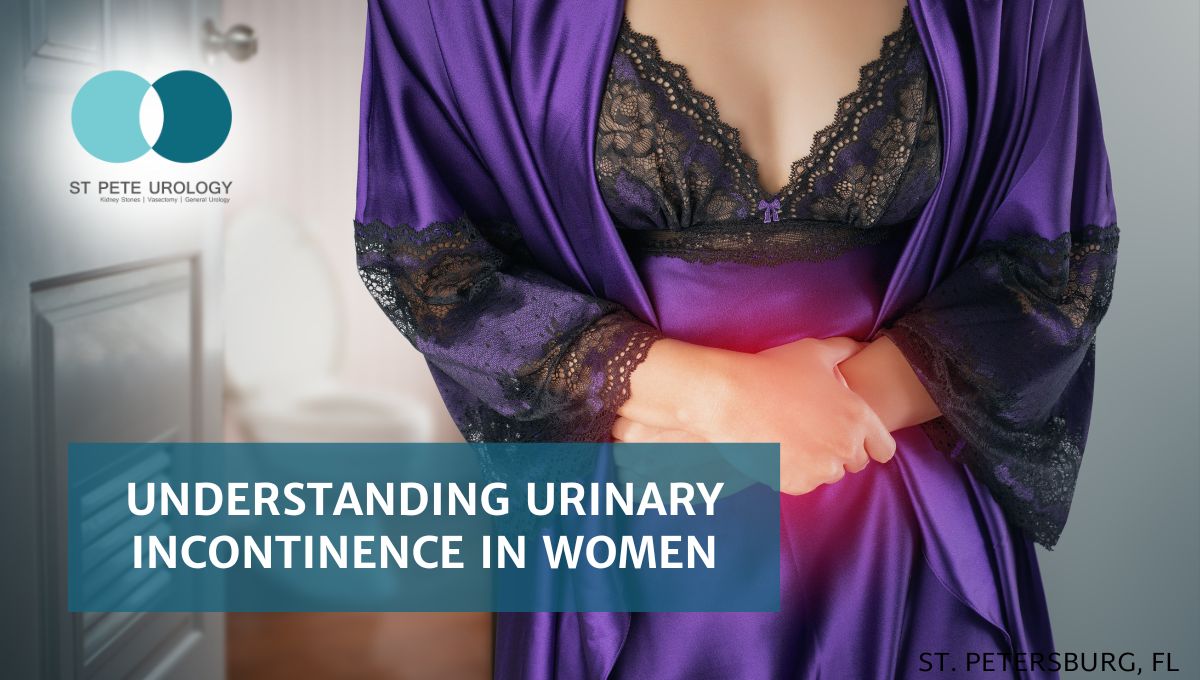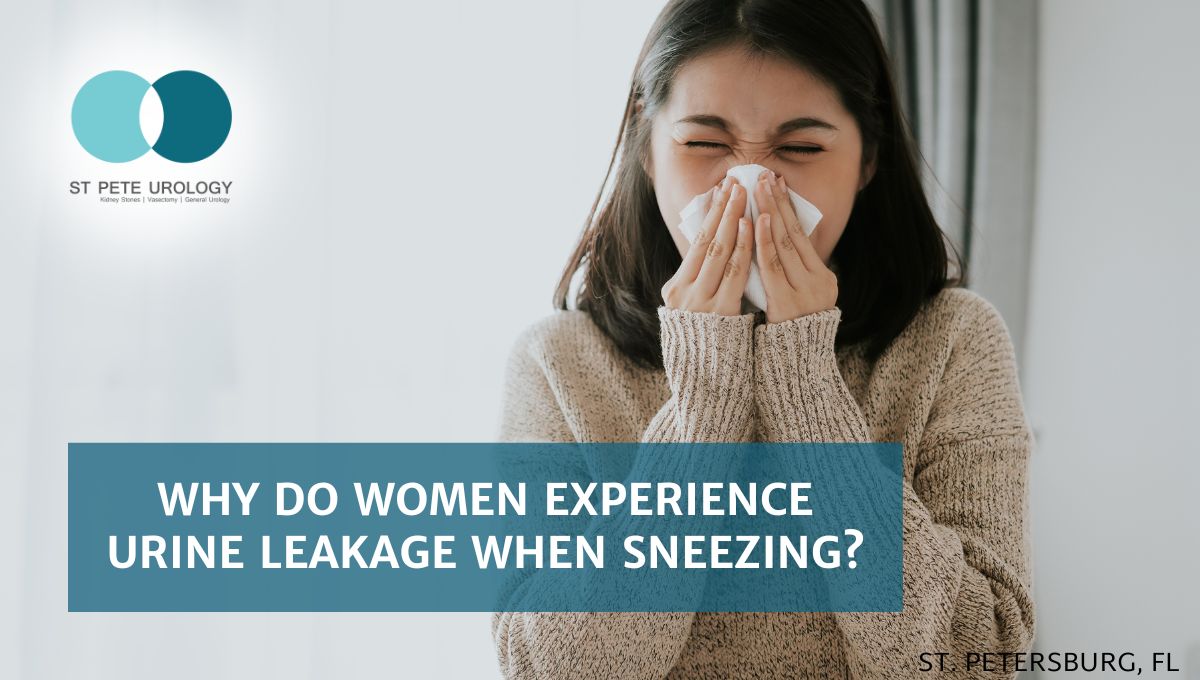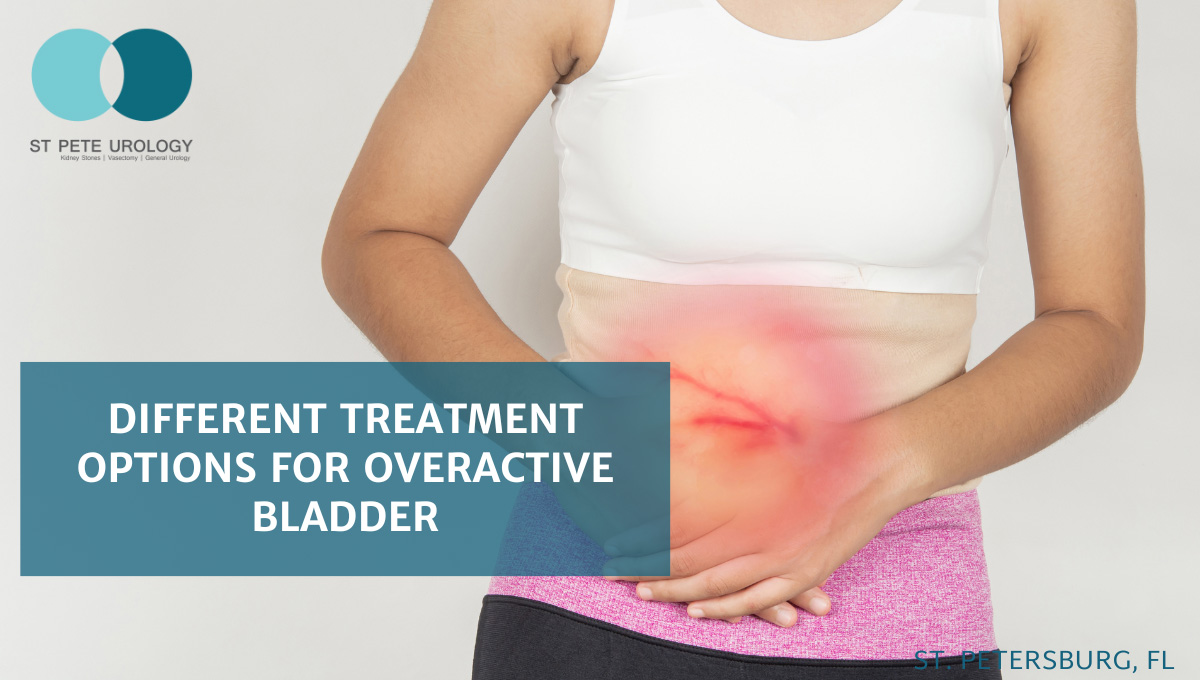Discover proven urinary incontinence treatment options and lifestyle changes. From pelvic exercises to surgical solutions, learn how to regain bladder control today.
Continue readingUnderstanding Urinary Incontinence in Women
Learn about urinary incontinence in women, affecting 60% of adult females. Discover causes, types, and effective treatment options from board-certified urologists in St Petersburg, FL.
Continue readingEffective Treatments for Stress Urinary Incontinence
Discover effective stress urinary incontinence treatments at St Pete Urology—conservative to surgical solutions tailored for St. Petersburg patients.
Continue readingWhy Do Women Experience Urine Leakage When Sneezing?
Urine leakage when sneezing is stress urinary incontinence. Learn causes, treatments & relief in St. Petersburg, FL.
Continue readingDifferent Treatment Options for Overactive Bladder
Understanding the different treatment options for overactive bladder will lead to a more accurate and personalized treatment plan.
Continue readingIs Your Bladder Healthy? Key Signs to Look Out For
Recognizing the key signs of a healthy bladder is important to monitor its condition and seek medical advice when necessary.
Continue readingKidney stones: What are your treatment options?
Experiencing kidney stones? What are your treatment options? The severity of the kidney stones may dictate which treatment to get.
Continue readingWhat Causes Incontinence
Dr. Nicholas Laryngakis discusses the factors on what causes incontinence and the complications and risks associated with the condition.
Continue readingWhat Does Your Urine Hue Say About Your Health?
Key Takeaways:
- Urine hue or color can be an indicator of health, with light yellow indicating good hydration and dark yellow or amber being a sign of dehydration or concentrated urine.
- Cloudy or milky urine can be a sign of urinary tract infection or kidney stones, while red or pink urine can be indicative of blood in the urine.
- Brown or dark-colored urine can be a sign of potential liver or kidney problems, and other factors like medications and diet can also influence the urine hue.
Have you ever considered how pivotal a role your urine plays as a diagnostic tool? Every day, your body performs countless actions behind the scenes, and one of them is the production of urine, which carries messages about your health status. This article aims to decode these telltale signs, unraveling an intimate connection between the hue of your urine and your wellbeing.
Understanding Urine Hue

Our exploration must start with an understanding of how urine gets its color. As your body processes water and nutrients, it simultaneously expels waste materials. Urobilins—waste substances—give urine its characteristic yellow color. The intensity of this color can vary, largely depending on your hydration level. Being well-hydrated typically yields a light yellow urine color—a sign of normal hydration and good health, like a badge of honor for the water-guzzlers among us.
Urine Color and Health Conditions
Dark yellow/amber urine color: Dehydration or concentrated urine
However, when your urine shifts to a dark yellow or amber color, it’s time to pay attention. This could be a sign of dehydration or concentrated urine. Chronic dehydration can lead to serious health risks, such as kidney stones or urinary tract infections. Ensuring to hydrate sufficiently—achieving that light yellow badge again—should be your first course of action.
Cloudy or milky urine color: Possible urinary tract infection (UTI) or kidney stones
Beyond this, a cloudy or milky hue could be indicative of a more concerning health issue—a potential urinary tract infection (UTI) or kidney stones. Such conditions can cause a significant alteration in urine color. If you notice this color shift, you should promptly seek a medical professional to get a proper diagnosis.
Red or pink urine color: Blood in the urine (hematuria)
Red or pink urine should set off your alarm bells—it can signal blood in the urine, a condition known as hematuria. Potential causes range from UTIs to kidney stones and even certain types of cancer. With such a wide spectrum of possibilities, promptly contacting a healthcare provider for further evaluation is paramount.
Brown or dark-colored urine: Potential liver or kidney problems
Meanwhile, a brown or dark-colored urine often signifies potential liver or kidney problems. Conditions like liver diseases or kidney disorders can lead to significant changes in urine color. Hence, if you observe such alterations, don’t hesitate to contact your healthcare provider to rule out these underlying conditions.
Other Factors Influencing Urine Color
Beyond health conditions, other factors like medications and your diet can influence the color of your urine. Certain prescription drugs, over-the-counter medicines, or supplements may alter your urine’s hue. Even some foods can temporarily change your urine color. For instance, beetroot might tint your urine pink or red, while asparagus can lend a greenish hue.
In conclusion, the color of your urine serves as a non-invasive health barometer. It’s an everyday diagnostic tool, and monitoring any changes in your urine color can provide early indications of potential health issues.
However, it is important to remember that while your urine can speak volumes, it doesn’t tell the complete story. Any concerns about urine color should prompt a visit to a healthcare professional for a proper diagnosis and treatment.
If you are in the St Petersburg, FL area and are seeking expert advice related to urine health or have any related symptoms, consider visiting St Pete Urology. With a team of experienced urologists, they are dedicated to providing comprehensive, top-quality care for the prevention, diagnosis, and treatment of urinary and urological disorders. Your urine color might be telling you something. Let the experts at St Pete Urology help you understand what it’s trying to say.
References:
- St Pete Urology. (2019, July 8). St. Pete Urology | Urologists in St Petersburg, Florida. St Pete Urology. https://stpeteurology.com/why-do-i-keep-getting-utis/
- Urobilin – American Chemical Society. (2021). American Chemical Society. https://www.acs.org/molecule-of-the-week/archive/u/urobilin.html
- Dehydration symptoms and treatments. (2020). NHSInform.scot. https://www.nhsinform.scot/illnesses-and-conditions/nutritional/dehydration
- and, D. (2023, August 14). Hematuria (Blood in the Urine). National Institute of Diabetes and Digestive and Kidney Diseases; NIDDK – National Institute of Diabetes and Digestive and Kidney Diseases. https://www.niddk.nih.gov/health-information/urologic-diseases/hematuria-blood-urine
What are the four main symptoms of an overactive bladder?
 The bladder is a hollow organ located in the abdomen that temporarily holds urine produced by the kidneys. As the bladder fills with urine, nerve signals are sent to the brain, which causes the urge to urinate. These signals from the brain coordinate the relaxation of pelvic floor muscles and urethral sphincter muscles. Then, it directs the bladder muscles to contract and expel urine through the urethra.
The bladder is a hollow organ located in the abdomen that temporarily holds urine produced by the kidneys. As the bladder fills with urine, nerve signals are sent to the brain, which causes the urge to urinate. These signals from the brain coordinate the relaxation of pelvic floor muscles and urethral sphincter muscles. Then, it directs the bladder muscles to contract and expel urine through the urethra.
An overactive bladder is a condition in which there is a loss of coordination of bladder muscles. The muscles responsible for urination have the remarkable ability to initiate contractions independently, even without direct signals from the brain. This intrinsic capability allows these muscles to expel urine through the urethra. This is a process that can occur even when the volume of urine in the bladder is relatively low. This results in an urgent, uncontrollable need to urinate, and may lead to urine leakage if a bathroom cannot be reached immediately. There are two types of overactive bladder: a dry form that occurs without an overwhelming urge to urinate (hence no urine leakage), and a wet form that is characterized by an uncontrollable need to urinate (therefore, leakage or involuntary voiding occurs).
Overactive bladder is a common problem, especially in older adults (though it is not a normal result of aging). It affects 1 in every 11 people in the United States, mostly those aged 60 and older. However, women may be affected earlier, often in their mid-forties.
The four main symptoms of an overactive bladder are:
Frequent urination:
Also called urinary frequency, this refers to an urge to urinate that is more frequent than usual. Urinary frequency can disrupt a normal daily routine or interfere with sleep. For example, while most people urinate 6-7 times per day after consuming about 2 liters of fluid, someone with urinary frequency may urinate 8 or more times within 24 hours.
Urgency:
Urinary urgency refers to a sudden, uncontrollable urge to urinate. It is caused by involuntary contractions of bladder muscles and feels like painful straining. Uncontrolled loss or leakage of urine may follow if a person is not able to urinate immediately. It tends to occur alongside, and is usually related to, urinary frequency.
Nocturia:
Waking up at least once each night to urinate is called nocturia. Normally, a person should be able to sleep for 6-8 hours without having to wake up to go to the bathroom. However, when a person has an overactive bladder, involuntary contractions of the bladder may occur at any time at night, leading to the need to wake up more than once every night to urinate. This can disrupt the normal sleep cycle and impact quality of life.
Unintentional loss of urine:
The strong, sudden, and uncontrollable urge to urinate that occurs in people with an overactive bladder is often followed by accidental loss or leakage of urine. This is because a person is not usually able to hold the urine long enough to reach the bathroom. Leakage of urine can be embarrassing and may force a person to avoid normal social or routine activities.
There are a number of effective treatments for an overactive bladder. These include behavioral strategies such as dietary changes, fluid schedules, prompted and timed voiding, bowel programs, and absorbent garments. However, if the symptoms of urinary incontinence become notably distressing or significantly disrupt one’s daily life, a doctor can opt to prescribe medications as part of the treatment plan. These medications may include antispasmodics or anticholinergics, such as tolterodine (Detrol), oxybutynin (Ditropan), oxybutynin skin patch (Oxytrol), trospium (Sanctura), or solifenacin (Vesicare). Their purpose is to reduce the number of urge episodes experienced by the individual.
An alternative treatment option is the sacral nerve stimulator. In this procedure, a pacemaker-type device is surgically placed under the skin of the abdomen. It is then connected to a wire that is positioned near the sacral nerves, which are located near the tailbone. This device can help regulate the bladder muscles and reduce the number of involuntary contractions.
It is important to see a doctor if you are experiencing symptoms of an overactive bladder, as it is a treatable condition. The doctor can help determine the underlying cause and recommend the appropriate treatment. In some cases, underlying medical conditions, such as urinary tract infection, may be contributing to the symptoms, and treating these conditions may improve bladder control.
Conclusion
In summary, an overactive bladder is a condition in which the bladder muscles contract involuntarily, leading to a strong, urgent need to urinate. This can cause frequent urination, urinary urgency, nocturia, and unintentional loss of urine. Urinary incontinence is more frequently observed among older adults. However, it’s important to note that it is not a natural consequence of aging. Fortunately, there are several effective methods available for managing and treating this condition. These methods encompass a range of approaches, including behavioral strategies and the use of medications. If you are experiencing symptoms of an overactive bladder, it is important to see a doctor for a proper diagnosis and treatment plan.
For more information on symptoms, diagnosis and treatment of an overactive bladder and other urological disorders, visit the site “St Pete Urology.”










